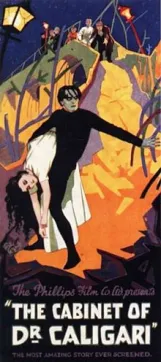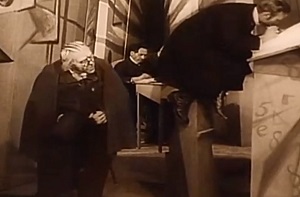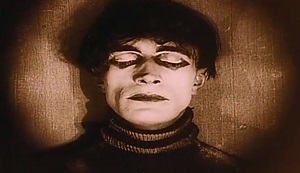(1920 Movie)
If you haven’t seen it:
 The Cabinet of Dr Caligari is a fascinating German silent film, often regarded as the first ever full-length (although it is only about an hour long) horror movie. The story, about a deranged doctor who hypnotically controls a murderous sleepwalker, is engaging enough, but what makes it so interesting is the way the film looks – stylized sets, outlandish acting, and unrealistic theatrical effects that caricature reality.
The Cabinet of Dr Caligari is a fascinating German silent film, often regarded as the first ever full-length (although it is only about an hour long) horror movie. The story, about a deranged doctor who hypnotically controls a murderous sleepwalker, is engaging enough, but what makes it so interesting is the way the film looks – stylized sets, outlandish acting, and unrealistic theatrical effects that caricature reality.
If you have seen it:
Scroll down past the trailer for more.
SPOILER ALERT: The plot summary and comments below contain details that might spoil your enjoyment of the movie if you have not already seen it.
Plot:

Tragically, ergonomics was invented too late to save this young clerk.
Francis, a young man, is talking to another man about his experiences with the sinister Dr Caligari, and the movie shows us this story in flashback.
Dr Caligari comes to town with a travelling fair. He has a show to put on, so goes to the Town Hall to apply for a permit, where a clerk treats him rudely. The next day, the clerk is found murdered.
Later, we see Dr Caligari putting on his show. In his tent he has a coffin-like cabinet, which contains a sleeping man. Calgari says the man is called Cesare, a somnambulist (sleepwalker) who has been asleep for 25 years. Bringing the somnambulist into a trance-like half awake state, Caligari tells Cesare to predict the future of a man in the audience (Francis’s friend, Alan), and Cesare says that the man will die before dawn. The prediction does indeed come true, because Cesare sleepwalks out at night and kills him.
Suspicion inevitably falls on the doctor and his eerie accomplice, but a copycat killer strikes, and is caught, and the police are temporarily fooled into thinking that Caligari and Cesare are innocent. Young Francis however, suspects the truth, and he and his fiance Jane begin to investigate the pair. This provokes Dr Caligari to order Cesare to kill Jane, but even in a trance Cesare cannot bring himself to kill one so beautiful; he kidnaps her and carries her off, but eventually he himself dies of exhaustion.
Francis traces Caligari to a mental institution in the next town. Forcing his way in, Francis is shocked to discover that Caligari is not, as he had expected, a patient there, but he is in fact the director. He learns that the director is obsessed with the story of an 11th century monk called Caligari who controlled a murderous somnabulist, and he is re-enacting that legend. When Francis exposes the doctor’s crimes, and tells Caligari that Cesare is dead, the doctor goes beserk, so the staff tie him up in a straight jacket and imprisoned in his own asylum.
Francis finishes telling the story, and the flashback ends. However, in a final twist, the movie reveals that the flashback was in fact actually a fantasy, and the truth is that Francis, Jane, and Cesare are all inmates in the asylum, and the mild-mannered and decent Calgari is their doctor.
Steve Sunday Says:

Cesare. The first goth. Or was he Emo? I can’t tell any more.
Cesare’s appearance profoundly disturbed viewers at the time, but it is unlikely to trouble modern viewers who grew up in a world in which “The Cure” regularly appeared on Top of the Pops. Far from being scared while watching him, I found myself yearning for the nightclubs I used to go to in the 1980s. I had a friend once who was a goth; I did admire his black hair and bangles, but I felt sorry for him in summer, wearing in his long leather coat and wishing he didn’t think he was too cool for shorts and a T shirt. Poor sweaty goths.
Far more chilling than Cesare, I thought, was Caligari himself. He looks exactly like the sort of person parents tell their children to stay away from. The sort of person that Operation Yewtree would want to have a long chat with. If the “25 years” claim was true, Caligari must have taken Cesare when he was a child.
I did enjoy this movie. It is a very old movie indeed, and I hope I am still interesting when I am nearly a hundred years old.
Trivia Trish Says:
- Conrad Veidt, who played Cesare, went on to play Major Heinrich Strasser in Casablanca.
- When The Cabinet of Dr Caligari premiered, the film was booed and jeered. It was temporarily withdrawn and reopened following a strong publicity campaign, and was a success second time around.
- The screenplay was written by a Czech poet and an Austrian artist. It was inspired by a real murder involving a travelling fair, which one of the writers partially witnessed.
- The technique of painting in the lighting effects, rather than using actual light and shadows, was used partly because of an electricity shortage.
- In 1948 a German writer called Siegfried Kracauer wrote a book called From Caligari to Hitler which suggested that The Cabinet of Dr Caligari was partly to blame for the rise of the Nazis. He drew comparisons between Cesare and the German people – both passive victims doing the evil bidding of a tyrannical false Messiah. He suggested the movie preconditioned the German people to go down that route. Quite how this would work, however, is beyond me.
- Fritz Lang (who made Metropolis) was involved early in production, and originally insisted that he had come up with the idea of the bookend framing device, but when the film assumed unwelcome political significance, he tried to distance himself from it.
- In 1962, there was a British remake called “The Cabinet of Caligari” scripted by Robert Bloch, who also wrote “Psycho”.
- In 1989 an absurd low budget semi-sequel was made called Dr. Caligari, about the granddaughter of the original Dr. Caligari. Avoid.
- In 1991 the film was remade as “The Cabinet of Dr. Ramirez” – a low budget art-house movie.
- In 1998 it was adapted as an opera.
- A number of rock and pop artists have referenced or claimed to have been influenced by this film. Rock band Rainbow paid tribute to the film in the 1983 video for “Can’t Let You Go”, as did Rob Zombie in 2009’s “Living Dead Girl”. Lady Gaga claimed the Cesare’s appearance influenced the look of her “Applause” CD cover and video. Also, 1980s goth band Bauhaus for some reason used a picture of Cesare on T-shirts for their single “Bela Lugosi’s Dead” which (I am guessing here) was a mistake that they later pretended was deliberate and/or ironic.


Chris the Critic says:
The strikingly cramped and crooked look of the town of Holstenwall was inspired by the work of the great “Expressionist” painter Edvard Munch. Stylistically, The Cabinet of Dr Caligari is unique, as none of the other homages to Expressionism which were made around the time have survived.
Did you notice that the outlandish set designs were present in the main story, but not in the bookends featuring Francis at the asylum. This was a clue to the viewer that the story was a fantasy – a technique also used to great effect in The Wizard of Oz (which also borrowed the idea of the narrator imagining a story incorporating characters from everyday life) nineteen years later.

Don’t ask me what painting triangles in a prison is supposed to “express”. I’m a movie critic not an art critic.
Main Cast and Crew:
Werner Krauss as Dr. Caligari
Conrad Veidt as Cesare
Friedrich Fehér as Francis
Lil Dagover as Jane Olsen
Written by Hans Janowitz and Carl Mayer
Directed by Robert Wiene
